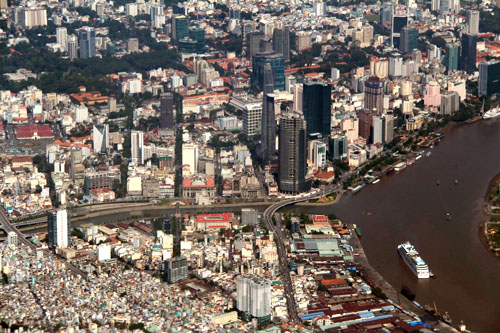CÔNG TY CỔ PHẦN ĐẦU TƯ NAM LONG (HOSE: NLG)
Số 6 Nguyễn Khắc Viện, P. Tân Phú, Quận 7, TP.HCM
Điện thoại: (84.28) 54 16 17 18
Fax: (84.28) 54 17 18 19
12/10/2018
According to the President of the Vietnam Urban Planning Development Association (VUPDA), the city needs more space to develop and address the challenges that it faces.
In the afternoon of October 11th, at the conference about Urban Management in Ho Chi Minh City: Current Situation, Problems and Solutions, Prof. Dr. Tran Ngoc Chinh (President of VUPDA) said that Ho Chi Minh City has a major impact on economy, culture and society so a regional planning is necessary to connect the area.
"The city has ample space, so the city planning cannot be studied separately but must be synchronized with the overall planning," Chinh said. However, it is ominous that HCMC is facing many serious challenges such as overpopulation, incomplete public transportation system, overloaded infrastructure, flooding, traffic jam....
In order to overcome these challenges and help the city to grow, Chinh suggested the Government to consider the option of expanding the city boundary by at least 600 km2.
HCMC has a total area of 2.096 km2, occupying 0.6% of the national area and housing 8.56% of the national population.
"This has not been previously proposed by any city manager but from an independent researcher’s standpoint, I think the expansion towards Long An will facilitate well the growth of the city”, he said.

The president of VUPDA proposed the first option, which uses Vam Co Dong River as a natural boundary and includes Can Giuoc, Can Duoc Districts and part of Ben Luc District. This would increase the total area of the city by 50 km2, with a population of about 370,000-420,000 people.
His second proposed option is to use Vam Co Dong as a natural boundary and include Duc Hoa, Can Giuoc districts, Can Dien district and part of Ben Luc district with an area of about 95 ha and a population of about 650,000 to 700,000 people.
Multi-center developing to reduce traffic jams and flooding
Meanwhile, Assoc. Prof. Dr. Luu Duc Cuong (Director of Vietnam Institute for Urban and Rural Planning - Ministry of Construction) warned about the concerning situation of land subsidence in Ho Chi Minh City. "Many areas in the city are sinking quickly and there are no signs of stopping." In 116 routes which often flooded by tides, 79 of them were affected by land subsidence," said Cuong.
On the other hand, former secretary of HCMC Party committee, Mr. Pham Chanh Truc thinks that there is a conflict between centralized and dispersed development. The city should have multi centers but we did the opposite – centralizing to District 1, 3.
"Such centralized urban construction is wrong, actually seriously wrong," said Truc, “ the city must be planned as a multi-center city for people to live, work, enjoy the place without having to go far. When we apply the multi-center solution, the problem of flooding, traffic jam will be much easier to address.
Re-organizing without expanding
Speaking at the conference, Secretary of the HCMC Party Committee, Nguyen Thien Nhan said that at the city’s current growth rate of 1 million people in 5 year, road and housing infrastructure development cannot keep up. This is a hard problem for the city.
The city has 5 districts which are small in size, and the smallest district is about 5 km2. District Can Gio is 704 km2, 140 times larger in size but it only has 70,000 people, while urban districts have up to 600,000 people – which is 8.7 times more.
Districts Can Gio and Cu Chi have altogether an area of 1,139 km2 with 900,000 people. Thus, the population of these 2 districts accounts for 10% of the total but the total area takes up 54%. "The administrative model of the city is extremely fragmented, and the city should not ask for more land but utilize land in these two areas. We will continue to consider expert’s proposal to complete the planning for Ho Chi Minh City," said Nhan.
Previously, at the opening speech, the Deputy Secretary of the Standing Committee Tat Thanh Cang wished that Ho Chi Minh City has new and sustainable civilized urban areas, creating more remarkable landscape architecture.
However, the area planning still has some limitations such as classification and connection of a high number of projects due to the missing of a national planning; regional planning while infrastructure planning is fragmented and lack of integration…
"The difficult problem of the city is the unbalance of capital required to invest in infrastructure development and the available budget. Each year, the budget can only account for 22% of the total costs for urban infrastructure development," Cang said.
By VnExpress.net
16/01/2024
The lively look of Mizuki Park Township